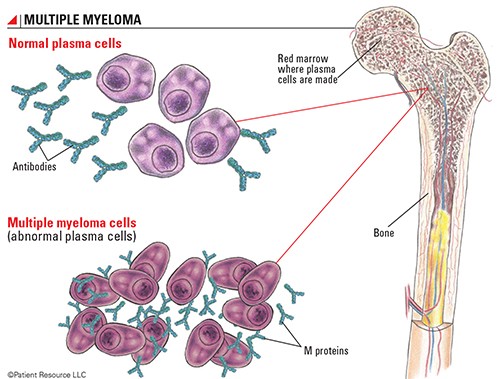
Recently Diagnosed or Relapsed? Stop Looking For a Miracle Cure, and Use Evidence-Based Therapies To Enhance Your Treatment and Prolong Your Remission
Multiple Myeloma an incurable disease, but I have spent the last 25 years in remission using a blend of conventional oncology and evidence-based nutrition, supplementation, and lifestyle therapies from peer-reviewed studies that your oncologist probably hasn't told you about.
Click the orange button to the right to learn more about what you can start doing today.
- You are here:
- Home »
- Blog »
- Multiple Myeloma »
- Living w/ Myeloma Since 2002- Long-term Survivor Story-
Living w/ Myeloma Since 2002- Long-term Survivor Story-

Gloria was 65 years old when she was diagnosed with Kappa Light Chain Multiple Myeloma in August 2002. She initially began to experience low back pain in April 2002 which gradually worsened over the next few months.
In all of my MM experiences since my diagnosis in early 1994, I have rarely seen as interesting a long-term survivor story such as the one discussed below. Gloria is a success story, plain and simple.
Gloria (last name withheld…) has been riding the MM roller coaster since her original diagnosis in July of 2002. A relatively low m-spike but serious bone involvement. Years of managing light chain MM, hypercalcemia and kidney involvement.
Perhaps most importantly, a treatment-related secondary cancer…that does not require treatment!
- Clinical trials do have a place in MM treatment-
- Top MM Hospitals can Make a Huge Difference-
- We all have good days and bad days as long-term MM survivors-
If you have a question or a comment, please scroll down to the bottom of the page and write a post. I will reply to you ASAP.
Thanks and hang in there…
David Emerson
- MM Survivor
- MM Cancer Coach
- Director PeopleBeatingCancer
Recommended Reading:
- Multiple Myeloma Chemotherapy Side Effect-Anemia
- What is the Most Definitive Test to Diagnose Multiple Myeloma?
- Multiple Myeloma Symptom- Kidney Damage- Natural Detox Therapies
Gloria initially thought that her pain was from golfing and saw a chiropractor, but she felt that this made her pain worse. In July 2002 she had an episode of acute, severe, pain, for which she was hospitalized.
While in the hospital, x-rays showed a T12 compression fracture and end plate compression of T4. A follow-up MRI revealed extensive marrow involvement including fractures of T12 and L2. Bone scans showed abnormalities in T12, L1, L2, ribs, and left scapula suggesting metastatic disease.
Follow-up tests showed elevated
- Kappa free light chains,
- Anemia,
- Hypercalcemia,
- and elevated Creatinine.
Due to the extensive involvement of her bones and the other lab results, she was diagnosed with Multiple Myeloma on July 26th, 2002.
A bone marrow biopsy in August 2002 showed 80% plasma cells by morphology that were predominantly kappa restricted. Despite the detection of an IgG Kappa paraprotein measuring 1.1 g/dl in July 2002, she was diagnosed with Kappa Light Chain Multiple Myeloma following the bone marrow biopsy in August.
Cytogenetic testing showed a normal karyotype and FISH testing did not reveal any abnormalities. Congo red staining was performed on a follow-up bone marrow biopsy in May 2018 and did not show any evidence of amyloid deposition.
Gloria received Zometa starting in April 2002, possibly to help treat osteopenia and continued with it after her diagnosis of Multiple Myeloma.
Following her diagnosis of Multiple Myeloma, she was treated with Vincristine, Adriamycin, and Decadron (VAD) for 4 cycles beginning in August 2002. Each cycle of treatment was accompanied by an injection of Neulasta.
Gloria achieved a Very Good Partial Response (VGPR- 90% reduction) to her chemotherapy and did not have significant complications though she did experience some fatigue and neuropathy of the fingers and toes.
She underwent chemo-mobilization using Cytoxan and Etoposide (VP-16) immediately followed by G-CSF and a Stem Cell Collection in January 2003. She underwent Melphalan conditioning followed by an Autologous Stem Cell Transplant using Interleukin-2 incubated stem cells in February 2003 as a part of trial NCT00006244.
She had no atypical side-effects or complications due to her transplant. Following her transplant, she was started on Interleukin-2 followed by Alpha Interferon in March 2003 on trial NCT00006244.
Gloria began Zometa (aredia?) in August 2003 with plans to continue this treatment for 5 years. After 4 years she discontinued the Alpha Interferon in March 2007 according to the trial protocol. In May 2006 she transitioned to every other month treatment with Aredia.
In February 2008, she began to receive Aredia more intermittently, eventually transitioning to a schedule of receiving the bisphophonate therapy every 3 months in February 2010.
She continued this schedule until September 2012 when she discontinued Aredia because she no longer required treatment with bisphosphonates.
In November 2015, 13 years after Gloria’s original diagnosis of MM, a bone marrow biopsy showed myeloblasts which was concerning for a myeloid neoplasm. The decision was made not to treat her because they were low-level.
In August 2016 a repeat bone marrow biopsy showed possible evidence of progression of her myeloid neoplasm and Gloria was also diagnosed with therapy-related myelodysplastic syndrome (t-MDS) on 8/2/16 due to decreased blood counts.
At the time treatment was discussed including options such as clinical trials or treatment with Dacogen, but the decision was made not to treat at this time and to watch and wait instead. In January 2017 a repeat bone marrow biopsy was stable leading to a discussion of whether Gloria had t-MDS or chronic myelomonocytic leukemia (CMML).
This remains somewhat unclear, but as of January 2019 Gloria’s MDS or CMML is stable and she remains off treatment and in remission.
As of this date still no treatment needed for CMML. Gloria will have another bone marrow biopsy in Sept. 2021.


